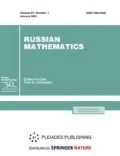Abstract
A.M. Lyapunov proved inequality, which enables us to estimate distance between two consecutive zeros a and b of the solution of linear differential equation of the second order x″(t) + q(t)x(t) = 0, where q(t) is a continuous for t ∈ [a, b] function. In the present paper we solve analogous problem for the linear differential equation x″(t) + p(t)x′(t) + q(t)x(t) = 0. The obtained inequality is applicable for estimations of the periods of periodic solutions of non-linear differential equations such as A. Lienard and B. Van der Pol equations.
Similar content being viewed by others
References
Lyapunov, A.M. “Stability of motion: general problem”, International J. Control 55 (3), 701–767 (1992).
Wintner, A. On the non-existence of conjugate points, American J. Math. 73, 368–380 (1951).
Yang Xiaojing “On Liapunov-type inequality for certain higher-order differential equations”, Appl. Math. and Computation 134 (2–3), 307–317 (2003).
Niculescu, C.P. “A new look at the Lyapunov inequality”, Ann. Academy Romanian Sci. Ser. Math. and Appl. 3 (1), 207–217 (2011).
Cheng Sui-Sun A discrete analogue of the inequality of Lyapunov, Hokkaido Math. J. 12, 105–112 (1983).
Zafer, A. “Discrete linear Hamiltonian systems: Lyapunov type inequalities, stability and disconjugacy criteria”, J. Math. Anal. and Appl. 396 (2), 606–617 (2012).
Agarwal, R.P., Özbekler, A. “Lyapunov type inequalities for second order forced mixed nonlinear impulsive differential equations”, Appl. Math. and Computation 282, 216–225 (2016).
Jlelia, M., Kiraneb, M., Sameta, B. “Lyapunov-type inequalities for fractional partial differential equations”, Appl. Math. Letters 66, 30–39 (2017).
Brown, R.C., Hinton, D.B. “Lyapunov inequalities and their applications” (in: Survey on Classical Inequalities. Math. and Its Appl. 517, pp. 1–25 (Kluwer Academic, Dordrecht, 2000)).
Hartman, P. Ordinary differential equations (Mir, Moscow, 1970) [in Russian].
Komlenko, Yu.V. “Conditions of solvability of certain boundary-value problems for ordinary linear differential equation of second order”, DAN USSR 174 (5), 1018–1020 (1967).
Liénard, A. “Étude des oscillations entreténues”, Revue genérale de l’électricité 23, 901–912 (1928).
Liénard, A. “Étude des oscillations entreténues”, Revue générale de l’électricité 23, 946–954 (1928).
Levinson, N., Smith, O. “A general equation for relaxation oscillations”, Duke Math. J. 9 (2), 382–403 (1942).
van der Pol, B. “On relaxation-oscillations”, The London, Edinburgh and Dublin Phil. Magazine and J. Sci. 2, 978–992 (1927).
Andronov, A.A., Vitt, A.A., Haikin, S.E. Theory of oscillations (2-nd ed.) (GIPhML, Moscow, 1959).
Wiggins, S. Introduction to Applied Nonlinear Dynamical Systems and Chaos (Springer, New York, 2003).
van der Pol, B., van der Mark, J. “The heartbeat considered as a relaxation oscillation, and an electrical model of the heart”, The London, Edinburgh and Dublin Philosophical Magazine and J. Sci. 6, 763–775 (1928).
Fitzhugh, F. “Impulses and physiological states in theoretical models of nerve membranes”, Biophysics J. 1, 445–466 (1961).
Nagumo, J., Arimoto, S., Yoshizawa, S. “An active pulse transmission line simulating nerve axon”, Proc. of the Institute of Radio Engineers 50, 2061–2070 (1962).
Glass, L. Theory of Heart (Springer, New York-Heidelberg-Berlin, 1990).
Salasnich, L. “Instabilities, point attractors and limit cycles in an inflationary universe”, Modern Phys. Letters A 10, 3119–3127 (1995).
Edelstein-Keshet, L. Mathematical Models in Biology (Random House, New York, 1988).
Poland, D. “Loci of limit cycles”, Phys. Review E 49, 157–165 (1994).
Albarakati, W.A., Lloyd, N.G., Pearson, J.M. “Transformation to Liénard form”, Electronic J. Diff. Equat. 76, 1–11 (2000).
Ignat’ev, A.O., Kirichenko, V.V. “On necessary conditions for global asymptotic stability of equilibrium for the Liénard equation”, Math. Notes 93 (1), 75–82 (2013).
Bowman, T.T. “Periodic solutions of Lienard systems with symmetries”, Nonlinear Anal. 2 (4), 457–464 (1978).
Carletti, T., Villari, G. “A note on existence and uniqueness of limit cycles for Liénard systems”, J. Math. Anal. and Appl. 307 (2), 763–773 (2005).
Odani, K. “Existence of exactly N periodic solutions for Liénard systems”, Funkcialaj Ekvacioj 39, 217–234 (1996).
Ignatyev, A.O. “The domain of existence of a limit cycle of Liénard system”, Lobachevskii J. Math. 38, 271–279 (2017).
Filippov, A.F. “A sufficient condition for the existence of a stable limit cycle for an equation of the second order”, Mat. Sb. (N.S.) 30 (72), 171–180 (1952).
Neumann, D.A., Sabbagh, L. “Periodic solutions of Lienard systems”, J. Math. Anal. and Appl. 62 (1), 148–156 (1978).
Sugie, J., Hara, T. “Non-existence of periodic solutions of the Lienard system”, J. Math. Anal. and Appl. 159 (1), 224–236 (1991).
Sabatini, M. “On the period function of Lienard systems”, J. Diff. Equat. 152, 467–487 (1999).
Ignatiev, A.O. “Estimation for the amplitude of the limit cycle of the Liénard equation”, Differential equations 53, 302–310 (2017).
Smirnov, A.D. “Lections on models of macroeconomy”, Higher School of Economics Economic J. 1, 87–122 (2000).
Meiss, J.D. Differential dynamical systems (Soc. Industrial and Appl. Math., Philadelphia, 2007).
Odani, K. “The limit cycle of the van der Pol equation is not algebraic”, J. Diff. Equat. 115 (1), 146–152 (1995).
Dorodnitsyn, A.A. “Asymptotic solution of Van der Pol’s equation”, J. Appl. Math. Mech. 11 (3), 313–328 (1947).
Sudakov, V.F. “On the question of limit cycle of the Van der Pol generator in relaxation regime”, Vestn. N.E. Bauman MGTU. Ser. Priborostroenie 1, 51–57 (2013).
Buonomo, A. “The periodic solution of van der Pol’s equation”, SIAM J. Appl. Math. 59 (1), 156–171 (1999).
Greenspan, D. “Numerical approximation of periodic solutions of van der Pol’s equation”, J. Math. Anal. Appl. 39, 574–579 (1972).
Akulenko, L.D., Korovina, L.I., Kumakshev, S.A., Nesterov, S.V. “Self-sustained oscillations of Rayleigh and Van der Pol oscillators with moderately large feedback factors”, J. Appl. Math. Mech. 68 (2), 241–248 (2004).
Author information
Authors and Affiliations
Corresponding author
Additional information
Russian Text © The Author(s), 2020, published in Izvestiya Vysshikh Uchebnykh Zavedenii. Matematika, 2020, No. 6, pp. 21–29.
About this article
Cite this article
Ignatiev, A.O. On the Lyapunov Type Inequality. Russ Math. 64, 16–23 (2020). https://doi.org/10.3103/S1066369X20060043
Received:
Revised:
Accepted:
Published:
Issue Date:
DOI: https://doi.org/10.3103/S1066369X20060043


